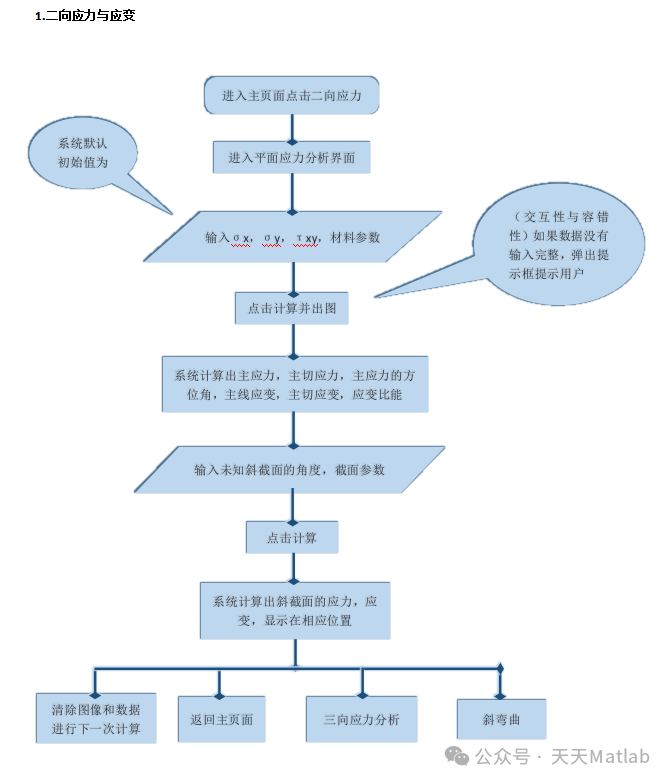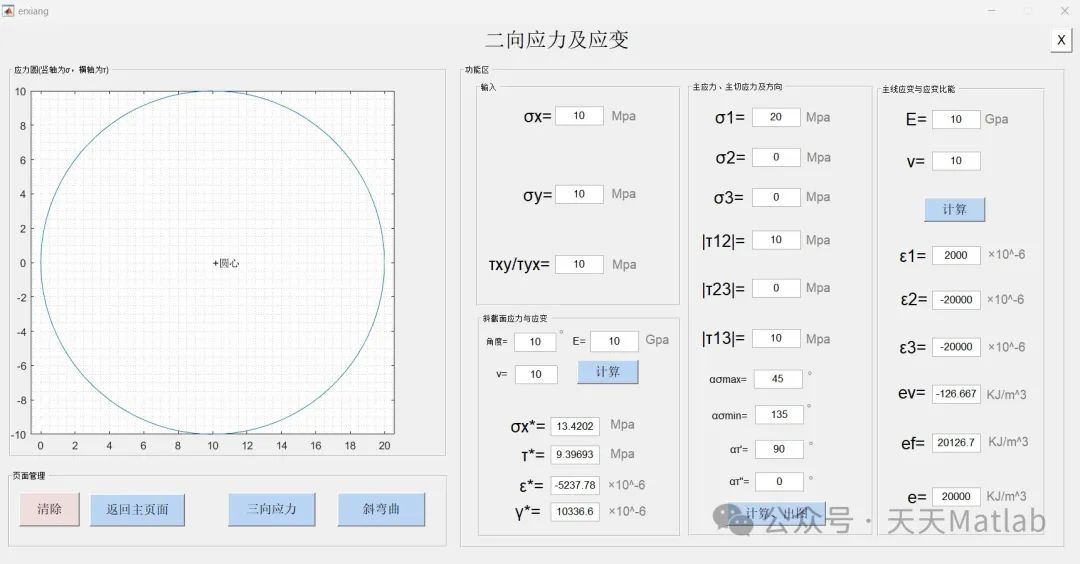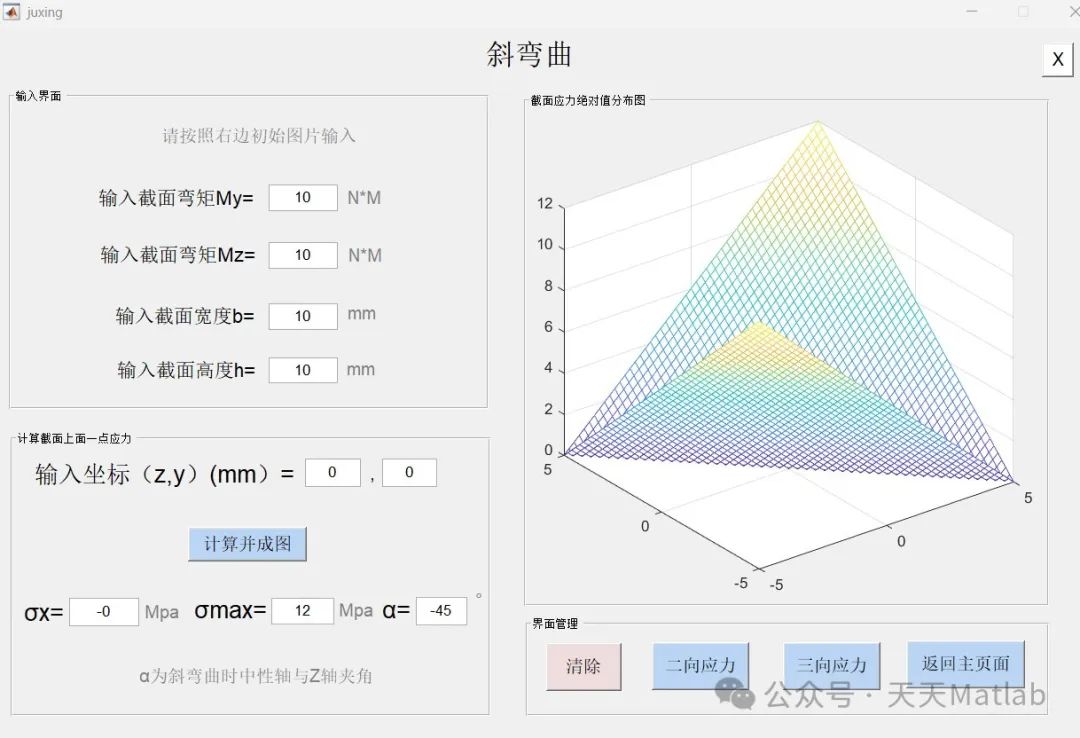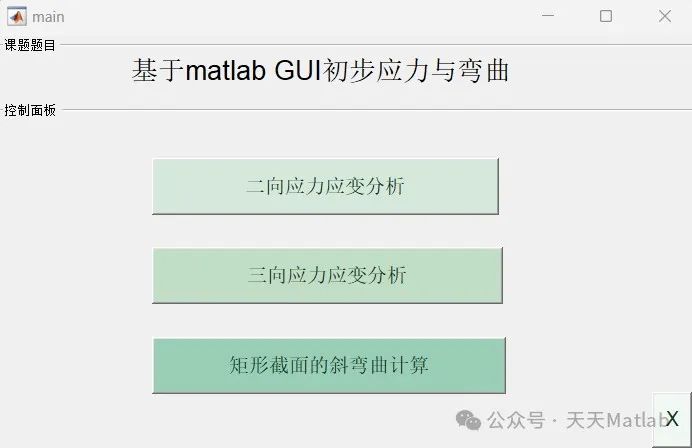✅ Author Introduction: A research enthusiast and Matlab simulation developer, skilled in data processing, modeling simulations, program design, acquiring complete code, paper reproduction, and scientific simulations.
🍎 Personal Homepage:Matlab Research Studio
🍊 Personal Motto: Seek knowledge through exploration, feel free to message for help.
🔥 Content Introduction
This article will explore the design and implementation of a mechanical calculation software aimed at engineering technicians, which can effectively analyze key mechanical parameters such as principal stress, principal strain, and strain energy ratio under biaxial stress, triaxial stress, and spatial stress states. The software also features a simple analysis function for slanted bending of rectangular cross-section beams. This article will focus on the software’s customer-facing main interface design and provide a brief overview of the core calculation modules.
Purpose: The program can analyze biaxial stress states, biaxial strain situations, triaxial stress states, and principal strain, strain energy ratios, and simple slanted bending analysis of rectangular cross-section beams.
Biaxial Stress State: Users input known normal stress, shear stress, inclined section angle, material parameters, and the system calculates the principal stress, principal shear stress, orientation angles of the principal planes and principal shear planes, normal stress, shear stress, linear strain, shear strain, total strain energy ratio, volumetric strain energy ratio, and shape strain energy ratio at a specific orientation angle.
Triaxial Stress State: Users input known normal stress, shear stress, and section coefficients, and the system calculates the principal stress, principal shear stress, draws the stress circle, principal linear strain, and strain energy ratio.
1. Software Function Overview
The software aims to provide engineers with a convenient and efficient mechanical calculation platform, covering the following core functionalities:
-
Biaxial Stress State Analysis: The software can calculate and output the following results based on user-inputted known normal stresses (σx, σy), shear stress (τxy), inclined section angle (θ), and material parameters (Elastic Modulus E, Poisson’s ratio μ):
-
Principal Stress (σ1, σ2): Represents the maximum and minimum normal stresses experienced by the material at that point.
-
Principal Shear Stress (τmax): Represents the maximum shear stress experienced by the material at that point.
-
Principal Plane Orientation Angle (θp): Represents the angle between the principal stress direction and the reference coordinate system x-axis.
-
Principal Shear Plane Orientation Angle (θs): Represents the angle between the plane of maximum shear stress and the reference coordinate system x-axis.
-
Normal Stress (σθ) and Shear Stress (τθ) at Any Orientation Angle: Based on the user-specified angle θ, calculates the normal and shear stresses on that plane.
-
Linear Strain (εx, εy, γxy): Based on generalized Hooke’s law, calculates the normal strains in the x and y directions and the shear strain in the xy plane.
-
Total Strain Energy Ratio (U): Represents the total strain energy stored per unit volume.
-
Volumetric Strain Energy Ratio (Uv): Represents the strain energy caused by volume changes stored per unit volume.
-
Shape Strain Energy Ratio (Us): Represents the strain energy caused by shape changes stored per unit volume. (Us = U – Uv)
Triaxial Stress State Analysis: The software can calculate and output the following results based on user-inputted known triaxial normal stresses (σx, σy, σz), shear stresses (τxy, τyz, τzx), and relevant section coefficients:
-
Principal Stress (σ1, σ2, σ3): Calculates the principal stresses in three directions at that point.
-
Principal Shear Stress (τmax): Calculates the maximum shear stress at that point.
-
Stress Circle: The software will draw Mohr’s circle to visually represent the triaxial stress state.
-
Principal Linear Strain (ε1, ε2, ε3): Calculates principal strains based on principal stresses and material parameters.
-
Strain Energy Ratio (U): Calculates the total strain energy per unit volume.
Spatial Stress State Analysis: The software will extend to handle more complex spatial stress states, using advanced methods such as tensor analysis for calculations.
Simple Slanted Bending Analysis of Rectangular Cross-Section Beams: The software can analyze the internal force distribution and deformation of rectangular cross-section beams under slanted bending loads based on user-inputted load, dimensions, and material parameters.
2. Customer-Focused Main Interface Design
The software’s main interface will adopt a modular design, clearly dividing various functional modules for user convenience. The interface design should follow these principles:
-
Intuitiveness: Use clear and simple icons and labels, avoiding technical jargon to enhance user experience.
-
Usability: Provide clear input fields and output areas for easy data entry and result viewing.
-
Reliability: Implement effective validation for user inputs to prevent calculation errors due to incorrect entries.
-
Scalability: Reserve interfaces for future extension of new functional modules.
For the biaxial stress state analysis, the interface will include the following input areas:
-
Material Parameter Input Area: Input Elastic Modulus E and Poisson’s ratio μ.
-
Stress Input Area: Input known normal stresses σx, σy and shear stress τxy.
-
Angle Input Area: Input inclined section angle θ.
-
Calculate Button: Click to initiate the calculation process.
-
Result Output Area: Display calculation results, including principal stress, principal shear stress, principal plane orientation angle, normal and shear stresses at any orientation angle, linear strain, strain energy ratio, etc. Results will be presented in tables and graphs for user comprehension.
For the triaxial stress state analysis, the interface will include similar input areas and add a display area for the stress circle. The result output area will include principal stress, principal shear stress, principal linear strain, strain energy ratio, etc.
3. Technical Implementation
The software’s backend will employ efficient numerical computation methods such as matrix operations and iterative algorithms to ensure calculation accuracy and speed. Programming languages can include Python, C++, or MATLAB, and will fully utilize relevant scientific computing libraries such as NumPy and SciPy. Frontend interface design may use GUI libraries such as Qt or Tkinter to create a user-friendly interactive interface. To ensure data accuracy, strict error handling and fault tolerance mechanisms will be implemented within the software.
4. Conclusion
This article briefly introduces the design and implementation of a mechanical calculation software, focusing on its customer-facing main interface design. By providing convenient calculation functions and intuitive interface design, the software will greatly enhance engineers’ work efficiency and aid in effectively solving engineering problems. Future work will focus on improving software functionality, enhancing calculation accuracy, and optimizing the user interface, ultimately creating a powerful, easy-to-use, and reliable engineering mechanics calculation tool.


📣 Part of the Code
ERXIANG(‘CALLBACK’,hObject,eventData,handles,…) calls the local
% function named CALLBACK in ERXIANG.M with the given input arguments.
%
% ERXIANG(‘Property’,’Value’,…) creates a new ERXIANG or raises the
% existing singleton*. Starting from the left, property value pairs are
% applied to the GUI before erxiang_OpeningFcn gets called. An
% unrecognized property name or invalid value makes property application
% stop. All inputs are passed to erxiang_OpeningFcn via varargin.
%
% *See GUI Options on GUIDE’s Tools menu. Choose “GUI allows only one
% instance to run (singleton)”.
%
% See also: GUIDE, GUIDATA, GUIHANDLES
% Edit the above text to modify the response to help erxiang
% Last Modified by GUIDE v2.5 30-Dec-2015 17:16:11
% Begin initialization code – DO NOT EDIT
gui_Singleton = 1;
gui_State = struct(‘gui_Name’, mfilename, …
⛳️ Running Results



🔗 References
🎈 Part of the theory is referenced from online literature. If there is any infringement, please contact the author for removal.
👇 Follow me to receive a wealth of Matlab e-books and mathematical modeling materials
🎁 Message for complete code and data acquisition as well as customized simulation for papers.
🌿 For past reviews, you can follow the homepage and click search.
🏆 The team specializes in guiding customized Matlab simulations in various research fields, assisting in achieving research dreams:
🌈 Various intelligent optimization algorithm improvements and applications
Production scheduling, economic scheduling, assembly line scheduling, charging optimization, workshop scheduling, departure optimization, reservoir scheduling, three-dimensional packing, logistics site selection, cargo space optimization, bus schedule optimization, charging pile layout optimization, workshop layout optimization, container ship loading optimization, pump combination optimization, medical resource allocation optimization, facility layout optimization, visibility-based base station and drone site selection optimization, knapsack problem, wind farm layout, time slot allocation optimization, optimal distributed generation unit allocation, multi-stage pipeline maintenance, factory-center-demand point three-level site selection problem, emergency life material distribution center site selection, base station site selection, road lamp post arrangement, hub node deployment, transmission line typhoon monitoring devices, container scheduling, unit optimization, investment optimization portfolio, cloud server combination optimization, antenna linear array distribution optimization, CVRP problem, VRPPD problem, multi-center VRP problem, multi-layer network VRP problem, multi-center multi-vehicle VRP problem, dynamic VRP problem, two-level vehicle routing planning (2E-VRP), electric vehicle routing planning (EVRP), oil-electric hybrid vehicle routing planning, mixed flow workshop problem, order splitting scheduling problem, bus scheduling optimization problem, flight shuttle vehicle scheduling problem, site selection routing planning problem, port scheduling, port bridge scheduling, parking space allocation, airport flight scheduling, leak source location.
🌈 Machine learning and deep learning time series, regression, classification, clustering, and dimensionality reduction
2.1 BP time series, regression prediction, and classification
2.2 ENS voice neural network time series, regression prediction, and classification
2.3 SVM/CNN-SVM/LSSVM/RVM support vector machine series time series, regression prediction, and classification
2.4 CNN|TCN|GCN convolutional neural network series time series, regression prediction, and classification
2.5 ELM/KELM/RELM/DELM extreme learning machine series time series, regression prediction, and classification
2.6 GRU/Bi-GRU/CNN-GRU/CNN-BiGRU gated neural network time series, regression prediction, and classification
2.7 Elman recurrent neural network time series, regression prediction, and classification
2.8 LSTM/BiLSTM/CNN-LSTM/CNN-BiLSTM long short-term memory neural network series time series, regression prediction, and classification
2.9 RBF radial basis neural network time series, regression prediction, and classification
2.10 DBN deep belief network time series, regression prediction, and classification
2.11 FNN fuzzy neural network time series, regression prediction
2.12 RF random forest time series, regression prediction, and classification
2.13 BLS broad learning time series, regression prediction, and classification
2.14 PNN pulse neural network classification
2.15 Fuzzy wavelet neural network prediction and classification
2.16 Time series, regression prediction, and classification
2.17 Time series, regression prediction, and classification
2.18 XGBOOST ensemble learning time series, regression prediction, and classification
2.19 Transform various combinations time series, regression prediction, and classification
Areas cover wind power prediction, photovoltaic prediction, battery life prediction, radiation source identification, traffic flow prediction, load forecasting, stock price prediction, PM2.5 concentration prediction, battery health status prediction, electricity consumption forecasting, water body optical parameter inversion, NLOS signal identification, precise subway parking prediction, transformer fault diagnosis.
🌈 In image processing
Image recognition, image segmentation, image detection, image hiding, image registration, image stitching, image fusion, image enhancement, image compressed sensing.
🌈 In path planning
Traveling salesman problem (TSP), vehicle routing problem (VRP, MVRP, CVRP, VRPTW, etc.), UAV three-dimensional path planning, UAV collaboration, UAV formation, robot path planning, grid map path planning, multimodal transportation problem, electric vehicle routing planning (EVRP), two-level vehicle routing planning (2E-VRP), oil-electric hybrid vehicle routing planning, ship trajectory planning, all-path planning, warehouse patrol.
🌈 In UAV applications
UAV path planning, UAV control, UAV formation, UAV collaboration, UAV task allocation, UAV secure communication trajectory online optimization, vehicle collaborative UAV path planning.
🌈 In communication
Sensor deployment optimization, communication protocol optimization, routing optimization, target location optimization, Dv-Hop location optimization, Leach protocol optimization, WSN coverage optimization, multicast optimization, RSSI location optimization, underwater communication, communication upload/download allocation.
🌈 In signal processing
Signal recognition, signal encryption, signal denoising, signal enhancement, radar signal processing, signal watermark embedding/extraction, electromyographic signals, electroencephalographic signals, signal timing optimization, electrocardiographic signals, DOA estimation, encoding/decoding, variational mode decomposition, pipeline leakage, filters, digital signal processing + transmission + analysis + denoising, digital signal modulation, bit error rate, signal estimation, DTMF, signal detection.
🌈 In power systems
Microgrid optimization, reactive power optimization, distribution network restructuring, energy storage configuration, orderly charging, MPPT optimization, household electricity.
🌈 In cellular automata
Traffic flow, crowd evacuation, virus spread, crystal growth, metal corrosion.
🌈 In radar
Kalman filter tracking, track association, track fusion, SOC estimation, array optimization, NLOS identification.
🌈 In workshop scheduling
Zero-wait flow shop scheduling problem NWFSP, replacement flow shop scheduling problem PFSP, hybrid flow shop scheduling problem HFSP, zero idle flow shop scheduling problem NIFSP, distributed replacement flow shop scheduling problem DPFSP, blocking flow shop scheduling problem BFSP.
👇